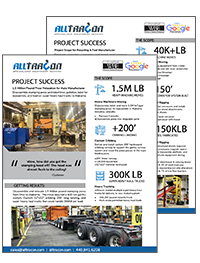Safety Tips for Industrial Storage and Warehousing
Ensuring safety in industrial storage and warehousing is critical to prevent accidents, protect employees, and maintain efficient operations. The complex environment of a warehouse, combined with the use of heavy equipment and the storage of various materials, necessitates stringent safety protocols. This guide covers essential safety tips to help create a safer workplace in industrial storage and warehousing settings.
Warehouse Layout and Design
A. Efficient Space Utilization
- Optimize Storage Space: Use vertical space effectively with tall storage racks and shelves to maximize storage capacity.
- Clear Aisles: Ensure that aisles are wide enough for the safe movement of forklifts and other machinery.
- Designated Areas: Clearly designate areas for different types of activities, such as loading/unloading zones, storage areas, and office spaces.
B. Signage and Labeling
- Clear Signage: Use clear and visible signage for emergency exits, hazard zones, and safety equipment.
- Labeling: Properly label all storage areas, racks, and materials to prevent confusion and ensure proper handling.
Equipment Safety
A. Forklift Safety
- Regular Inspections: Conduct daily inspections of forklifts to ensure they are in proper working condition.
- Training: Ensure that all forklift operators are trained and certified according to OSHA standards.
- Safe Operation: Encourage safe driving practices, such as maintaining a safe speed, using horns at intersections, and avoiding sudden turns.
B. Storage Racks and Shelving
- Load Limits: Clearly mark and adhere to load limits on storage racks and shelves to prevent collapse.
- Securing Loads: Ensure that all items are securely placed on racks and shelves to prevent falling objects.
- Regular Maintenance: Conduct regular inspections and maintenance of storage racks and shelving to identify and address any structural issues.
Handling Hazardous Materials
A. Proper Storage
- Segregation: Store hazardous materials separately from non-hazardous materials and from each other, as per compatibility guidelines.
- Ventilation: Ensure proper ventilation in areas where hazardous materials are stored to prevent the buildup of dangerous fumes.
- Containment: Use appropriate containers and secondary containment methods to prevent spills and leaks.
B. Training and PPE
- Training: Provide comprehensive training on the handling and storage of hazardous materials, including emergency response procedures.
- Personal Protective Equipment (PPE): Ensure that employees have access to and wear the necessary PPE, such as gloves, goggles, and respirators, when handling hazardous materials.
Fire Safety
A. Prevention Measures
- Fire Hazards: Identify and mitigate potential fire hazards, such as flammable materials and electrical issues.
- Housekeeping: Maintain a clean and clutter-free warehouse to reduce the risk of fire.
B. Fire Protection Systems
- Fire Extinguishers: Ensure that fire extinguishers are easily accessible and regularly inspected.
- Sprinkler Systems: Install and maintain automatic sprinkler systems to provide immediate response in case of fire.
- Emergency Exits: Clearly mark and keep emergency exits unobstructed.
Ergonomics and Manual Handling
A. Proper Lifting Techniques
- Training: Educate employees on proper lifting techniques to prevent musculoskeletal injuries.
- Assistive Devices: Provide tools and equipment, such as pallet jacks and lift tables, to assist with heavy lifting.
B. Ergonomic Workstations
- Design: Design workstations to minimize repetitive motion and awkward postures.
- Adjustability: Use adjustable furniture and equipment to accommodate different body sizes and shapes.
Employee Training and Awareness
A. Safety Training Programs
- Comprehensive Training: Provide ongoing safety training that covers all aspects of warehouse operations, including equipment use, emergency procedures, and hazard recognition.
- Refresher Courses: Regularly conduct refresher courses to keep employees updated on safety protocols.
B. Safety Meetings
- Regular Meetings: Hold regular safety meetings to discuss recent incidents, near misses, and safety improvements.
- Employee Involvement: Encourage employees to participate in safety meetings and share their observations and suggestions.
Emergency Preparedness
A. Emergency Response Plan
- Develop a Plan: Create a comprehensive emergency response plan that addresses various potential emergencies, such as fires, chemical spills, and natural disasters.
- Communication: Establish clear communication channels for alerting employees and coordinating emergency response.
B. Drills and Simulations
- Regular Drills: Conduct regular emergency drills to ensure that employees know how to respond in case of an emergency.
- Evaluate and Improve: After each drill, evaluate the response and identify areas for improvement.
Housekeeping and Maintenance
A. Cleanliness
- Regular Cleaning: Implement a regular cleaning schedule to keep the warehouse clean and free of debris.
- Spill Management: Have procedures in place for the prompt cleanup of spills to prevent slips and falls.
B. Equipment Maintenance
- Preventive Maintenance: Establish a preventive maintenance program for all equipment to ensure it remains in safe working condition.
- Immediate Repairs: Promptly address any equipment malfunctions or damage to prevent accidents.
Environmental Control
A. Climate Control
- Temperature and Humidity: Monitor and control the temperature and humidity in the warehouse to protect sensitive materials and ensure employee comfort.
- Ventilation: Ensure proper ventilation to maintain air quality and reduce the risk of airborne contaminants.
B. Lighting
- Adequate Lighting: Provide adequate lighting throughout the warehouse to ensure visibility and reduce the risk of accidents.
- Emergency Lighting**: Install emergency lighting that activates in case of power failure to guide employees to safety.
Security Measures
A. Access Control
- Restricted Access: Limit access to the warehouse to authorized personnel only to prevent unauthorized entry and theft.
- Surveillance Systems: Install surveillance cameras and security systems to monitor and record activities within the warehouse.
B. Inventory Management
- Regular Audits: Conduct regular inventory audits to ensure accuracy and identify any discrepancies.
- Theft Prevention: Implement measures to prevent theft, such as background checks for employees and secure storage for valuable items.
Conclusion
Safety in industrial storage and warehousing is a multifaceted challenge that requires a comprehensive approach. By focusing on warehouse layout and design, equipment safety, handling hazardous materials, fire safety, ergonomics, employee training, emergency preparedness, housekeeping, environmental control, and security measures, companies can create a safer and more efficient working environment. Regularly reviewing and updating safety protocols is essential to adapt to new challenges and ensure ongoing compliance with safety regulations.


